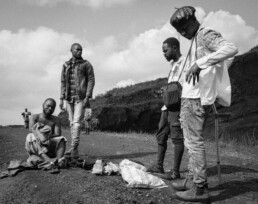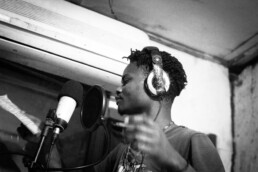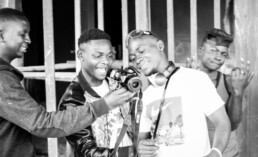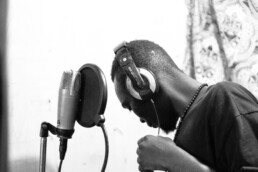The Bukavu Series online exhibition explores the power dynamics between researchers from the Global North and the Global South.
Lorem ipsum dolor sit amet, consectetur adipiscing elit. Nulla finibus lacinia enim, sit amet ultrices mi sodales sed. Cras consectetur orci vitae faucibus luctus. Cras auctor lectus a risus aliquet, eget efficitur risus fringilla. Integer aliquam finibus eros, eu rutrum lectus rhoncus ut. Donec ac neque tempor est porta molestie.
Street Life
Maarten Hendricks
One afternoon in March 2016, one of the gang leaders I was doing research with asked me: ‘Martin, can’t we make a film? A fiction film on our lives as sportifs (martial arts practitioners) and gangs in Goma?’ He told me that he and his friends had already written 4 a script. The whole group immediately became excited about the idea, fantasizing out loud about how they would become stars of their own action movie. I said yes for a number of intuitive reasons. When they are narrating past events to each other – for example fights with other gangs, encounters with the police, their time working in the mines or locked up in prison – these youths dramatize their own lives. ‘My life is like a movie’ or ‘I have lived a lot of movies’ are sentences that arise repeatedly. ‘It was like in this movie …’, after which they start to interpret their everyday events through the martial arts and action movies they like to watch. In fact, much as the Western genre served as an imaginary for the bill movement in colonial Kinshasa of the fifties, the martial arts genre represented by Bruce Lee, Jean Claude van Damme, Jet Lee, Jim Morris etc., underpins the imaginary of sportifs and gangs in Goma today (Olander n.d.). They are often trained in more than one discipline of martial arts, the techniques of which they learn from watching these movies. The leader of a gang bears the title of maitre (master) in the martial arts, and trains his/her disciples in what they call a temple. Further, in their everyday kigang practices they take over moral and behavioral codes from this film genre. For example, like Bruce Lee, a good sportif has to restrain himself from fighting against a non-sportif, since his/her body is a weapon. Only in self-defense can he can fight back. Now they wanted to make a movie, a fiction on their own lives, depicting their lifeworld as they saw fit.
In my view, Street Life is essentially a performance of everyday kigang (the style of being gang) political performances. In From Ritual to Theatre, Victor Turner asserts that cultural performances are metacommentaries. They are stories groups tell themselves about themselves ‘or in the case of theatre, a play a society acts about itself – not only a reading of its experience but an interpretative reenactment of its experience’ (Turner 1982, 104). Street Life, too, is such a metacommentary. It is a film starring gangs who play themselves and re-enact their own experiences as everyday policing actors. In other words, it is a reflexive exercise in which they ‘actively’ – if not necessarily faithfully – mirror their lifeworld the way they see fit (ibid.). The actors carefully reflected upon how (not) to represent themselves and communicate with their audience – first and foremost, people living in Goma. It was exactly this mirroring exercise that rendered the production of a fiction film ethnographically exciting. In sum, while my observations pointed out how performance is key in how gangs seek to carve out a political space for themselves as everyday policing actors, the making of Street Life led me to discover performance and filmmaking as a method. I thereafter made a ‘discovery’ similar to the one Fabian discusses in his well-acknowledged Power and Performance:
‘Performance’ seemed to be a more adequate description both of the ways people realize their culture and of the method by which an ethnographer produces knowledge about that culture (Fabian 1990, 18).
Extract from the article ‘‘My Life is Like a Movie’ Making a Fiction Film as a Route to Knowledge Production on Gang Political Performances in Goma, DR Congo” (Hendriks 2019)
(Olander n.d.; Fabian 1990; Hendriks 2019; Turner 1982)
Fabian, Johannes. 1990. Power and Performance: Ethnographic Explorations through Proverbial Wisdom and Theater in Shaba, Zaire. Madison, Wis: University of Wisconsin Press.
Hendriks, Maarten. 2019. “‘My Life Is Like a Movie’: Making a Fiction Film as a Route to Knowledge Production on Gang Political Performances in Goma, DR Congo.” Journal of Extreme Anthropology 3 (1): 57–76. https://doi.org/10.5617/jea.6695.
Olander, Eric. n.d. “The Enduring Popularity of Chinese Kung Fu Movies in Africa.” The Chinafrica Project. Accessed May 23, 2019. https://chinaafricaproject.com/podcast-china-africa-kung-fu-bruce-lee-movies-cobus-van-staden/.
Turner, Victor. 1982. From Ritual to Theatre: The Human Seriousness of Play. New York, NY: PAJ Publications.
Is a postdoctoral fellow at the Conflict Research Group (UGent). His research ethnographically focusses on practices of everyday politics in Goma, the provincial capital of North Kivu (DRC). More precisely his PhD research examined how gang and Anti-gang subjectivities are shaped in the city.
The Co-Production of Video Clips
Sam Kniknie
Is a Phd fellow at the Conflict Research Group, UGent. His research looks at urban protest in the conflict-ridden city of Goma, DRC. Building on an ethnographic approach, he looks how youth in urban peripheries engage in practices of urban protest and how their subjectivities are molded by experiences of political violence and state violence.
More specifically, he looks how the agents of urban protest challenge and confirm the concept of the state, how violence is both an experience and a form of agency for youth in urban peripheries and how state violence is getting shape in postcolonial and (post-)conflict regimes.
These music videos are the outcome of long ethnographic fieldwork among political youth collectives and social movements in Goma, Democratic Republic of Congo. In an attempt to conduct research in a more collaborative way, Ghent-based researcher Sam Kniknie took on the role of co-producer during the recording of songs and videos with youth in the urban peripheries of Goma. Using these audio-visual methods gives space and time to youth to perform the political ideologies and imaginaries that are often shaping the chaotic moments of protest and political violence, which are the focus of the research project.
Four songs are featured here: Deux Antennes, Non MONUSCO, Mungu ata kuita and Nyiragongo. Each of the songs offers a different lens onto the lives of young political activists in Goma. For example, they show how youth construct their own identity through music, how they perform longer histories of contention and how these youth experience their encounters with the Congolese state. Looking at their performances opens up new ways to make sense of the imaginaries and identities of politically active youth.
This project is a collaborative undertaking and some people deserve a special mention. Many thanks and acknowledgements go to DJ Vic Pro, Luneyo Chady Baba and Delcat Pro, the music and video producers who made this project possible. The outcome would not have been the same without their efforts. The same holds for the youth of 2 Antennes Show, who allowed a foreign researcher into their lives and demonstrated great musical talent. All credit belongs to them.




